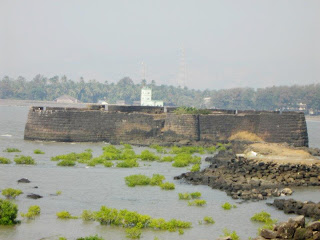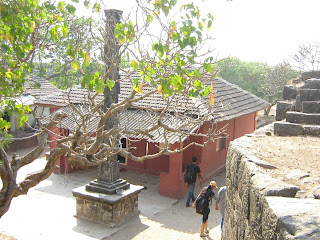Pic: photo 1885
Later the fort came under the sway of the legendary maratha admiral Sarkhel Kanhoji Angre (as per his treaty with Peshwa Balaji Vishwanath in the early 18th century ). It remained with his family for quite some time before it passed hands with the Siddis of Janjira, the Portuguese and the British. In 1722 there is a mention of a failed joint operation by the Portuguese and the English to capture the fort.
The fort is situated on an low rocky island (900 ft N-S, and 350 ft E-W) a few (1-2) kilometers from the Alibaug mainland.
During high tide the path is covered by sea water and has to be accessed by a motorboat, while during low tide the journey can be made in a tonga.
The fort has seventeen bastions (were named as Pinjala,Nagarkhani,Tofkhan
The fort walls have a parapet area alongside and one can have a view of the Arabian sea from there.The fort was once guarded by a 1000 infantry and 700 cavalry that were permanently stationed on the fort.
Alongside the main fort is a smaller twin fort called Sarjakot that defended the main fort from artillery attack from the mainland.
The fort mainly served as a watchpost to look over sea traffic in the nearbv trading port villages of Nagaon,Chaul and Revdanda.
Pic: Mahadarwaza
One enters the fort through the Mahadarwaza (main entrance) and a secondary doorway (perpendicularly located to the main entrance).
Pic:tomb of Sufi saint?
The fort also houses several edifices (now in ruins) including mansions belonging to Nani baisaheb the widow of Kanhoji Angre, Thorla wada built by Raghuji Angre Jr,Yesaji Angre wada,Manikcha wada,Karkunmandali wada,Sadar,storehouses,administrative offices,residences for the soldiers and families,Yashwantdari,Talaghara (basement),Sadar (court)gardens etc.There is also a doorway facing the sea towards the south.
The fort also hosts the temple of Ganesha Panchayatan which was built by Raghuji Angre Sr.
Inside the temple is a intricately carved doorframe that leads inside the sanctum.
The garbhagriha (sanctum) houses beautiful idols of Ganesha,Devi,Surya,Samb (Shiva) and Vishnu.
Outside the temple are minor temples of Mahadevi and Hanuman.
Pic:Tulsi vrindavan
Pic: deepamala (tower of lights)
Alongside is also a haud or water reservoir (called the Apsara talao).
Pic:Bhavani temple
Pic:Gulbai ?
Pic: Bopdev/ Kanoba?
The fort was destroyed by the British and the wood was burnt (1842 & 1875). The stones were used for building the Alibaug waterworks.
The fort also holds two British cannons (dated 1849 & 1851) which fired warning signals if a ship approached dangerously close.
Currently the fort is being maintained by the Archaelogical Survey of India (ASI).
Entrance fees charged are Rs 5/- per person for Indian nationals and Rs 100/- for foreign nationals.
Boat charges are Rs 100/- per person and waiting time at the fort is 45 mins-1 hr.
Miscellaneous photos:
Pic: Gabhara doorstep
Pic: Garbhagriha doorframe of Ganesh temple
Pic: Boat departure for Kolaba fort
Pic: Alibaug mainland
Pic: Alibaug beach (boat departure pt)
Pic: entrance of Ganesh temple
Pic: Insignias / Fort iconography on Mahadarwaza
Pic: fountain at Ganesh temple
Pic: Sarkhel Kanhoji Angre statue



























































Very Nice photos. Keep it up.....
ReplyDeleteAshish
www.KonkanOnline.com
Nice blog on kolaba fort. Kolaba fort is famous fort in Alibaug, Maharashtra. If you are like to visit forts and want to history behind fort then visit http://maharashtraplanet.com/forts-in-maharashtra/
ReplyDeleteNice and Informative Images
ReplyDeletehttp://www.holidaygb.in/
Nice and Informative Images
ReplyDeletehttp://www.holidaygb.in/